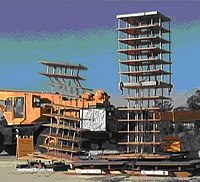
Photo from wikipedia
Abstract Stay-in-place formwork (SIPF) systems have increasingly been employed in construction technology because of their ease of construction and optimised labour cost. In this paper, the structural performance of concrete… Click to show full abstract
Abstract Stay-in-place formwork (SIPF) systems have increasingly been employed in construction technology because of their ease of construction and optimised labour cost. In this paper, the structural performance of concrete columns encased with SIPFs by the proprietary name of AFS-Logicwall (LW) and AFS-Rediwall (RW) is investigated using experimental and numerical studies under concentric axial loading. AFS-LW consists of fibre cement board (FCB) as an outer encasement attached to internal cold-formed steel studs using a proprietary adhesive, while AFS-RW is comprised Polyvinyl Chloride (PVC) interlocked panels acting as a permanent encasement. Lab tests on twelve short column specimens were undertaken that included six AFS-LW and AFS-RW columns (three of each) as well as six standard columns (STCs) designed in accordance with Australian Standard (AS3600) as benchmark samples. The axial and lateral displacements and compressive strains as well as axial loads were measured in the course of lab tests using instrumentation of samples. Numerical models of AFS-encased columns as well as STCs, utilising the finite element (FE) approach are developed using calibrated constitutive material models to predict nonlinear structural responses of columns. The rational calculation of confining pressure applied to the core of columns as a result of transverse reinforcements, steel studs, the FCB and the PVC encasement is explicitly obtained with consideration of triaxial stresses across all sections in FE models. The test measurements are employed to validate the FE models and it is confirmed that there is a good correlation between simulation and experiment. The FE models are then used to clarify the importance of different geometrical and mechanical parameters on the behaviour of AFS-LW and AFS-RW columns. As the study in this paper is to identify the composite behaviour between SIPFs and encased concrete columns according to general experimental and numerical approaches, it can be extended to wide variety of SIPFs with different materials. In accordance with the requirements set out in AS3600 for column capacity calculation based on rigorous analyses and experimental testing, it is shown that the confinement offered by the FCB and stud elements in AFS-LW and the PVC encasement in AFS-RW provides equivalent axial strength when appropriately designed U bar systems are used in lieu of the hoop and crosstie configuration primarily required under AS3600 rules.
Journal Title: Construction and Building Materials
Year Published: 2020
Link to full text (if available)
Share on Social Media: Sign Up to like & get
recommendations!